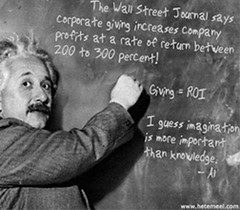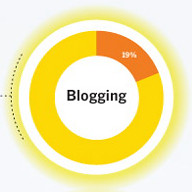As part of National Volunteer Week, I wanted to remind everyone that The Wall Street Journal picked up on a study from the Social Science Research Network (SSRN) back in January. It deserves more attention. The study revealed corporate giving can increase company profits at a rate of return of 200 to 300 percent.
The study, examined 251 corporate donors and their giving contributions from 1989 to 2000. Led by Prof. Baruch Lev at New York University’s Stern School of Business, the researchers found that corporate giving is associated with subsequent sales growth, particularly when consumer perception is important.
(Side note: This information has been around for some time. As far back as 1999, one report, from Cone/Roper Cause Trends Report, noted that 76 percent of consumers said they would switch brands/retailers to one associated with a good cause if price and quality are equal.)
Keep in mind, most of the firms in the SSRN study spent 50 times more on marketing than philanthropy, and their average giving was only 0.1 percent of average sales revenue. Still, the rate of return on giving exceeds the investment and, depending on what a company considers measurable results, business giving and volunteer programs deliver substantial benefits inside as well as outside a company, especially for small businesses with limited resources.
Business Giving Benefits
• Improves customer loyalty; impacts profitability
• Increases employee morale, loyalty, and productivity
• Establishes new internal and external relationships
• Improves internal communication and teamwork
• Enhances employee recruitment and retention
• Encourages new approaches to strategic business objectives
• Positions a company as a leader in the community
• Increases brand recognition and community awareness
Employee Volunteer Benefits
• Strengthens employee leadership and decision-making skills
• Encourages teamwork to develop positive communication
• Enables unrelated departments to interact and network
• Reduces work-related stress and increases morale
• Creates a better quality of life where employees live and work
• Increases employee awareness and interest in community issues
• Generates increased sense of patriotism, citizenship and civic pride
• Develops a community-minded culture, improving customer service
You see, most programs don't have to be large, cumbersome, costly, or time-consuming to develop win-win-win solutions. The best starts can be as simple as thinking about what your company can do.
For example, just today, we reported on TXU Electric Delivery's partnership with the Rogers Wildlife Rehabilitation Center. The company relies on the center to rescue and remove birds, including blue herons, that have nested in electrical equipment.
To support the center, TXU Electric Delivery is raising funds by recycling printer ink cartridges and used cell phones; some employees have also volunteered to work on a number of special projects at the center this summer. It's simple, effective, and everyone wins: the company, the employees, the center, and the community.
While I'm not sure if TXU Electric Delivery has a formal giving program, I do see they've taken the first steps. Mostly, however, I just like their case study because it demonstrates how relatively easy it is for a company to develop some type of program, formal or informal.
Here are a few other tips we've picked up along the way from working with nonprofit organizations and dozens of companies:
Create A Statement: Some people might call it a mission for a strategic philanthropy program, but I suggest smaller companies or independent professionals keep it simple. The real goal is to define when and how your company can best give back.
Choose A Niche: Focus on a specific need or a few needs within your community, which will give your company a better chance to measure results within the community. You can choose something that is important to your employees or closely aligned with what your company provides.
Develop A Road Map: Many companies will call it a strategy, but what we're really talking about is a road map to help you get where you want to go. For example, one company we know has an advocacy campaign aimed at increasing its role as a specialty provider in elementary school curriculum.
You can learn more about business philanthropy on this blog. In 2005, I republished a three-year-old article I wrote on the topic for the publication we were managing at the time. Don't let the date fool you; or that the entire article is tucked in the comments section. (I posted it back when I was led to believe all blog posts had to be short ... darn those useless rules other people promote!)
The article, Business Philanthropy | The Impact of Giving, included interviews with Microsoft, Salesforce.com, and the Business Community Investment Council.
I'll be happy to post more on business giving and community relations in the future, assuming there is an interest in the subject. Right now, we simply post best case studies on our other blog.
Next week, I'll be back to offering up some biting commentary on some communication disasters we missed this week, including a few sad thoughts on a few groups hoping to capitalize on the tragedy at Virginia Tech. Publicity, ho hum, indeed.

The study, examined 251 corporate donors and their giving contributions from 1989 to 2000. Led by Prof. Baruch Lev at New York University’s Stern School of Business, the researchers found that corporate giving is associated with subsequent sales growth, particularly when consumer perception is important.
(Side note: This information has been around for some time. As far back as 1999, one report, from Cone/Roper Cause Trends Report, noted that 76 percent of consumers said they would switch brands/retailers to one associated with a good cause if price and quality are equal.)
Keep in mind, most of the firms in the SSRN study spent 50 times more on marketing than philanthropy, and their average giving was only 0.1 percent of average sales revenue. Still, the rate of return on giving exceeds the investment and, depending on what a company considers measurable results, business giving and volunteer programs deliver substantial benefits inside as well as outside a company, especially for small businesses with limited resources.
Business Giving Benefits
• Improves customer loyalty; impacts profitability
• Increases employee morale, loyalty, and productivity
• Establishes new internal and external relationships
• Improves internal communication and teamwork
• Enhances employee recruitment and retention
• Encourages new approaches to strategic business objectives
• Positions a company as a leader in the community
• Increases brand recognition and community awareness
Employee Volunteer Benefits
• Strengthens employee leadership and decision-making skills
• Encourages teamwork to develop positive communication
• Enables unrelated departments to interact and network
• Reduces work-related stress and increases morale
• Creates a better quality of life where employees live and work
• Increases employee awareness and interest in community issues
• Generates increased sense of patriotism, citizenship and civic pride
• Develops a community-minded culture, improving customer service
You see, most programs don't have to be large, cumbersome, costly, or time-consuming to develop win-win-win solutions. The best starts can be as simple as thinking about what your company can do.
For example, just today, we reported on TXU Electric Delivery's partnership with the Rogers Wildlife Rehabilitation Center. The company relies on the center to rescue and remove birds, including blue herons, that have nested in electrical equipment.
To support the center, TXU Electric Delivery is raising funds by recycling printer ink cartridges and used cell phones; some employees have also volunteered to work on a number of special projects at the center this summer. It's simple, effective, and everyone wins: the company, the employees, the center, and the community.
While I'm not sure if TXU Electric Delivery has a formal giving program, I do see they've taken the first steps. Mostly, however, I just like their case study because it demonstrates how relatively easy it is for a company to develop some type of program, formal or informal.
Here are a few other tips we've picked up along the way from working with nonprofit organizations and dozens of companies:
Create A Statement: Some people might call it a mission for a strategic philanthropy program, but I suggest smaller companies or independent professionals keep it simple. The real goal is to define when and how your company can best give back.
Choose A Niche: Focus on a specific need or a few needs within your community, which will give your company a better chance to measure results within the community. You can choose something that is important to your employees or closely aligned with what your company provides.
Develop A Road Map: Many companies will call it a strategy, but what we're really talking about is a road map to help you get where you want to go. For example, one company we know has an advocacy campaign aimed at increasing its role as a specialty provider in elementary school curriculum.
You can learn more about business philanthropy on this blog. In 2005, I republished a three-year-old article I wrote on the topic for the publication we were managing at the time. Don't let the date fool you; or that the entire article is tucked in the comments section. (I posted it back when I was led to believe all blog posts had to be short ... darn those useless rules other people promote!)
The article, Business Philanthropy | The Impact of Giving, included interviews with Microsoft, Salesforce.com, and the Business Community Investment Council.
I'll be happy to post more on business giving and community relations in the future, assuming there is an interest in the subject. Right now, we simply post best case studies on our other blog.
Next week, I'll be back to offering up some biting commentary on some communication disasters we missed this week, including a few sad thoughts on a few groups hoping to capitalize on the tragedy at Virginia Tech. Publicity, ho hum, indeed.




















